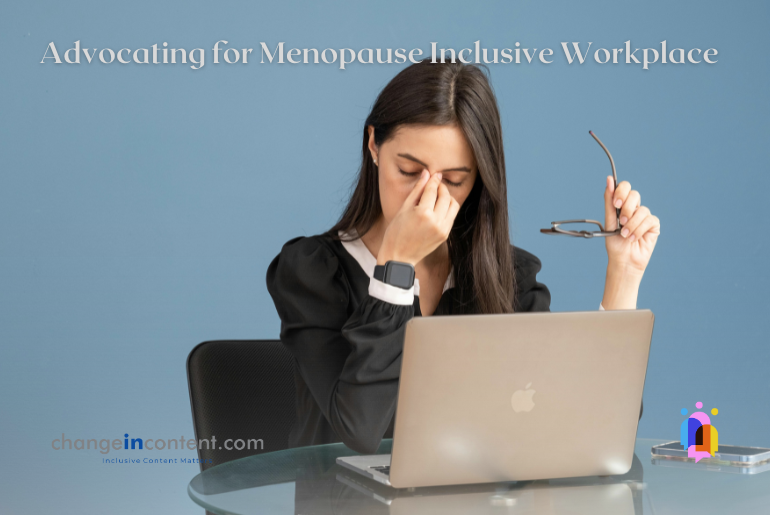Menopause is a natural phase occurring typically between ages 45 and 55 as oestrogen levels decline. It is a normal part of ageing in a woman’s life. Nearly eight out of ten women experience menopause while working. Despite its prevalence, employers often overlook how menopause affects women’s professional lives. They fail to adequately address or support the challenges women face at work during this time. These challenges include symptoms that impact their performance and well-being. Even in workplaces where women are the majority, employers are slow to acknowledge menopause as a genuine issue. It leaves many women feeling unsupported and demands advocacy for a menopause inclusive workplace.
Silenced by ageism
The challenges women face during menopause aren’t just about stigma but also about ageism, which seems to hit older women harder. Ageism, it’s like sexism. But discriminates based on age rather than gender. In most workplaces, women often bear the brunt of both ageism and sexism, where the stigma of being a female and getting older is frequently biased against them.
Older women who face ageism in the workplace might feel pressured to work harder than their younger colleagues to prove their worth. They may fear that taking time off or seeking support for menopausal symptoms could further jeopardise their jobs. This situation can create a reluctance among women to seek the care and support they need during menopause.
Menopause inclusive workplace: The personal experience of Pamela Hutchinson
Pamela Hutchinson OBE, Bloomberg’s Global Head of Diversity and Inclusion, candidly shared her journey with menopause on LinkedIn, opening with the question, “Is it hot in here, or is it just me?” Her high-profile job involved daily interactions with top leaders while overseeing a global team of over 40 people. However, the physical symptoms like sweating, itching, and forgetfulness began to shake her confidence in the workplace.
Before hitting the post button, she hesitated, feeling vulnerable, but was astonished by the overwhelming response. Her candid post resonated globally, triggering a wave of solidarity as others shared their own experiences with menopause or offered support. This viral moment showed that there is a huge need to talk openly about menopause at work and stop keeping it a secret.
How to make a menopause inclusive workplace
Not all women experience symptoms, but for those who do, they can range from hot flashes and brain fog to depression and sleep difficulties. Many women hesitate to talk about their menopause symptoms for fear of being labelled as “hysterical,” “incompetent,” or a “nuisance.” The stigma surrounding menstruation adds to their stress.
Menopause remains a taboo topic in everyday conversation, making it challenging for women experiencing severe symptoms to discuss it openly, especially with male family members or male colleagues. These challenges, combined with low awareness, lead many women to choose long career breaks or leave their jobs entirely.
Menopause inclusive workplace: The policies and steps to consider
When setting up policies, programs, and incentives to support those going through menopause, keep these in mind:
Flexibility: It’s about creating an environment where women can continue working, no matter what life throws at them. Whether it’s adjusting hours, offering remote options, or giving them a breather when needed, being flexible can really help women dealing with menopause.
Gender Inclusive: Not everyone who experiences menopause identifies as a woman, and not all women go through menopause. Transgender individuals can also experience menopause or similar symptoms, although the hormonal processes involved may differ from those experienced by cisgender individuals.
Access to Toilets: Toilets in the workplace often become a significant issue, particularly when accessibility is limited. This problem can be especially distressing during menopause when the need for privacy and convenience is high. Non-gendered toilets are a practical solution as they are inclusive and accommodate the needs of all individuals, regardless of gender identity.
Ensure Privacy: Being open about menopause can pose safety concerns for genderqueer or trans men. It’s important not to demand proof or details about how individuals manage their reproductive health. Instead, provide paid menstrual and menopause leave options for team members to use as needed.
Revise Your Workplace Policies: Are your policies really supportive enough for those going through menopause? If not, it’s time for a serious revision. Create a workplace where menopause is normalised and accepted as naturally as menstruation and pregnancy.
The final thoughts
Just as we roll out policies for expecting mothers, it’s high time we show similar care for those going through menopause. Such policies go beyond mere health and employee happiness. They are about building inclusivity and recognising the diverse needs of employees as they navigate different stages of their lives and careers.
Menopause doesn’t make women less competent. By fostering a supportive culture, employers can keep experienced talent and boost diversity. Being menopause-aware benefits businesses financially by retaining skilled staff, reducing absences, and avoiding turnover costs. Inclusive practices and empathy build unity and support in the workplace.
Disclaimer: The views expressed in this article are based on the writer’s insights, supported by data and resources available both online and offline, as applicable. Changeincontent.com is committed to promoting inclusivity across all forms of content, which we define broadly to include media, policies, law, and history—encompassing all elements that influence the lives of women and genderqueer individuals. Our goal is to promote understanding and advocate for comprehensive inclusivity.


